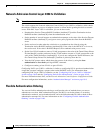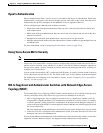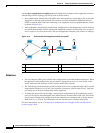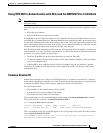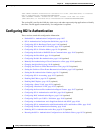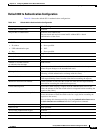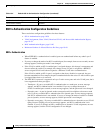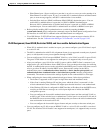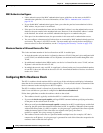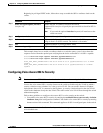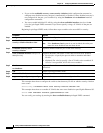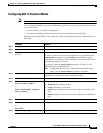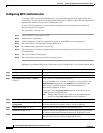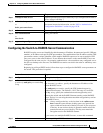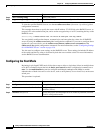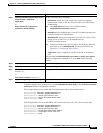
10-40
Catalyst 2960 and 2960-S Switch Software Configuration Guide
OL-8603-09
Chapter 10 Configuring IEEE 802.1x Port-Based Authentication
Configuring 802.1x Authentication
MAC Authentication Bypass
• Unless otherwise stated, the MAC authentication bypass guidelines are the same as the 802.1x
authentication guidelines. For more information, see the “802.1x Authentication” section on
page 10-38.
• If you disable MAC authentication bypass from a port after the port has been authorized with its
MAC address, the port state is not affected.
• If the port is in the unauthorized state and the client MAC address is not the authentication-server
database, the port remains in the unauthorized state. However, if the client MAC address is added
to the database, the switch can use MAC authentication bypass to re-authorize the port.
• If the port is in the authorized state, the port remains in this state until re-authorization occurs.
• You can configure a timeout period for hosts that are connected by MAC authentication bypass but
are inactive. The range is 1to 65535 seconds. You must enable port security before configuring a
time out value. For more information, see the “Configuring Port Security” section on page 23-8.
Maximum Number of Allowed Devices Per Port
This is the maximum number of devices allowed on an 802.1x-enabled port:
• In single-host mode, only one device is allowed on the access VLAN. If the port is also configured with
a voice VLAN, an unlimited number of Cisco IP phones can send and receive traffic through the voice
VLAN.
• In multidomain authentication (MDA) mode, one device is allowed for the access VLAN, and one
IP phone is allowed for the voice VLAN.
• In multiple-host mode, only one 802.1x supplicant is allowed on the port, but an unlimited number
of non-802.1x hosts are allowed on the access VLAN. An unlimited number of devices are allowed
on the voice VLAN.
Configuring 802.1x Readiness Check
The 802.1x readiness check monitors 802.1x activity on all the switch ports and displays information
about the devices connected to the ports that support 802.1x. You can use this feature to determine if the
devices connected to the switch ports are 802.1x-capable.
The 802.1x readiness check is allowed on all ports that can be configured for 802.1x. The readiness
check is not available on a port that is configured as dot1x force-unauthorized.
Follow these guidelines to enable the readiness check on the switch:
• The readiness check is typically used before 802.1x is enabled on the switch.
• If you use the dot1x test eapol-capable privileged EXEC command without specifying an interface,
all the ports on the switch stack are tested.
• When you configure the dot1x test eapol-capable command on an 802.1x-enabled port, and the link
comes up, the port queries the connected client about its 802.1x capability. When the client responds
with a notification packet, it is 802.1x-capable. A syslog message is generated if the client responds
within the timeout period. If the client does not respond to the query, the client is
not 802.1x-capable. No syslog message is generated.
• The readiness check can be sent on a port that handles multiple hosts (for example, a PC that is
connected to an IP phone). A syslog message is generated for each of the clients that respond to the
readiness check within the timer period.



